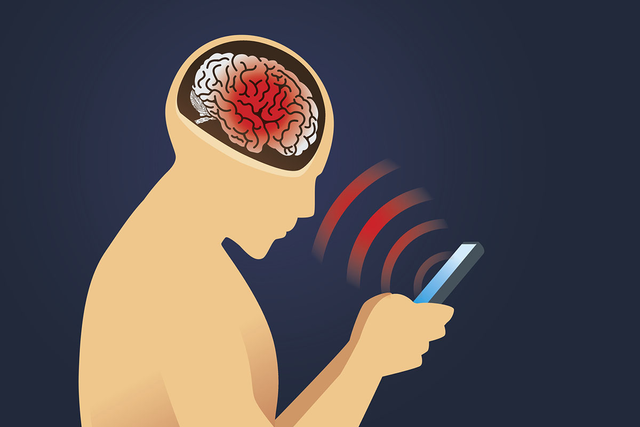
Back in 1993, a Florida resident named David Reynard went on CNN’s Larry King Live to warn about the dangers of cell phone radiation. He said it caused his wife’s brain tumor. Ever since, the question of whether cell phones cause cancer has buzzed quietly in the background as the technology has become omnipresent in our lives.
Numerous studies of cell phone radiation and cancer have been conducted over the years to address the issue, but none has been definitive.
To obtain more solid evidence, a team of scientists at the National Toxicology Program, a division of the National Institutes of Health, undertook an in-depth study. Their approach was to expose laboratory rodents to high doses of cell phone radiation over their entire life span and see if they developed cancer as a result. The study cost $20 million and took more than ten years to complete. Final results were released to the public in November 2018.
To the surprise and alarm of many, the investigators found what they called “clear evidence” that cell phone radiation could cause a type of nerve tissue cancer called a malignant schwannoma in rats. They also reported finding what they said was “some evidence” in the animal studies that cell phone radiation could cause a brain cancer called glioma.
These results generated some scary-sounding news headlines. But according to Lawrence Dauer, a radiation expert at MSK, there’s no reason to freak out just yet.
“The bottom line is it’s a really cool study,” Dr. Dauer says. “But we have to recognize the limitations that come along with it.”
Those limitations fall into three main categories, he says: statistical challenges, extrapolating lessons from rodents to humans, and questions about dosing.
Small Numbers, Big Inconsistencies
In their study, the National Toxicology Program investigators zapped more than 1,200 rats and mice with cell phone radiation — equivalent to that emitted by 2G and 3G phones — over their entire body for nine hours a day for two years. (The amounts given were more than are permitted for humans by the Federal Communications Commission.) They then looked in different tissues for signs of cancer.
They found that 6% of the male rats exposed to the highest dose of cell phone radiation developed malignant schwannomas in the heart, while 2 to 3% developed gliomas in the brain. None of the control rats (which did not receive radiation) developed either cancer.
These cancers are generally rare in humans, and also deadly, so if cell phone radiation increases their incidence, it is something to worry about indeed. However, there are reasons to doubt these numbers, Dr. Dauer explains. The total number of rats in each treatment group was 90. Six percent of 90 is five rats. Three percent is two rats. When sample sizes are small, simple chance can play a large role in the outcomes.
Making this result more difficult to interpret is that, for unknown reasons, the control rats did not live as long as the experimental rats. Because cancer affects animals more as they age, it’s possible that the control rats simply didn’t live long enough to develop tumors. (In past studies, some of the control animals have developed these types of tumors.)
A further curiosity about the study was that only male rats seemed to be affected. The female rats, female mice, and male mice were not affected.
“All told, these features of the study make it difficult to judge whether the cancer effect was real,” he says.
Rats Are Not Humans
Even if the results had been more consistent, it would still be difficult to know what they mean for human health. Though rodents are useful tools for learning about basic biology, they don’t necessarily indicate how humans will respond. Since the radiation was more intense and given over the whole body, it is hard to extrapolate the danger to human health. The radiation was also representative of an older form of cell phone technology, 2G and 3G. Fourth generation (4G) phones are in use now and 5G ones are about to be released.
When making safety recommendations, public health officials typically place more weight on evidence from human studies or trials. In the case of cell phones, several large human studies have been conducted to analyze the potential link between cell phone use and brain cancer. Typically, these are studies in which individuals with brain tumors are surveyed about their cell phone use and compared with individuals without brain tumors. Overall, these studies do not show a link between cell phone use and cancer.
“Any individual study might find something unusual,” Dr. Dauer says. “But what’s most important to consider is the weight of evidence across all of them.” And that, he says, does not show any clear link between cell phones and cancer.
Nor do the available data on cancer incidence show that rates of brain cancer are increasing.
“A questioning scientist might say, ‘Well, we just haven’t used them long enough to see an effect on cancer rates.’ That’s why it’s important to continue to study this,” he adds.
An ongoing study called COSMOS that is being conducted in several European countries is following cell phone users for 20 to 30 years.
Not All Radiation Is the Same
When trying to convey an accurate assessment of radiation risk, public health officials run into problems because of confusion over the term.
“Say the word ‘radiation’ and depending on your generation, you’re thinking either Teenage Mutant Ninja Turtles or the atomic bomb,” Dr. Dauer says. “You can’t see it, taste it, smell it, or touch it, and you feel like you can’t do anything about it. So it becomes something very scary.”
But cell phone radiation is actually very low in energy. On the spectrum of electromagnetic radiation, which also includes visible light, cell phone radiation falls between FM radio waves and microwaves. These low-frequency forms of energy are referred to as nonionizing radiation because they are not strong enough to knock atoms off molecules. This is in contrast to ionizing radiation, such as X-rays and gamma rays. These high-frequency waves can indeed damage molecules and have been linked to cancer. (The former are emitted by X-ray machines, while the latter are emitted by radioactive materials.)
The argument that cell phones cause cancer lacks biological plausibility because the energy contained in the waves is too low to cause damage. “There’s no mechanism that we can come up with yet,” Dr. Dauer says. “That doesn’t mean that there might not be one, but it could be so mild or insignificant that it doesn’t show up in an epidemiological study.”
So what’s the take home for average users who want to protect themselves from what may not even be a real danger?
“Use an earpiece or speakerphone if you want,” Dr. Dauer says. “But there are far more concrete dangers of cell phones to worry about, such as texting while driving.”
Addendum added May 21, 2019:
Several readers of this blog post have asked questions about the safety of 5G technology. The study under discussion evaluated radiofrequency radiation from 2G and 3G phones and therefore cannot be extrapolated to 4G or 5G models. But here is what we can say:
Cell phones (and other radiofrequency-emitting devices) are characterized by the frequency of the radiation they use. Early models (2G and 3G) used radiofrequencies in the range of 800 megahertz (MHz) to 1.9 gigahertz (GHz). The 4G range is 700 MHz to 27 GHz. The 5G range will be 600 MHz to 39 GHz. Radiofrequencies in the higher range are actually less able to penetrate the body than lower radiofrequencies, so the risk of these waves doing damage to internal organs is also lower. The frequencies the human body absorbs most efficiently are in the range of 30 to 300 MHz.
While radiofrequency radiation cannot ionize molecules, it can heat them. This is how microwave ovens work. But to heat molecules, the radiation must be given at very high power, on the order of thousands of watts per kilogram (kg). Current safety standards limit cell phones to a maximum of 1.6 watts per kg, which is not enough to warm the body. This safety limit applies to 5G cell phones as well.
In the study discussed in this post, the power ranged from 1.5 to 6 watts per kg of body weight in rats and 2.5 to 10 watts per kg in mice — thus, in most cases, much higher than the maximum allowed power for humans.
When your phone gets hot, it’s because of the battery, not the radiofrequency.
Additional information can be found here:
https://www.nytimes.com/2019/05/12/science/5g-phone-safety-health-russia.html
https://www.vox.com/2018/7/16/17067214/cellphone-cancer-5g-evidence-studies




